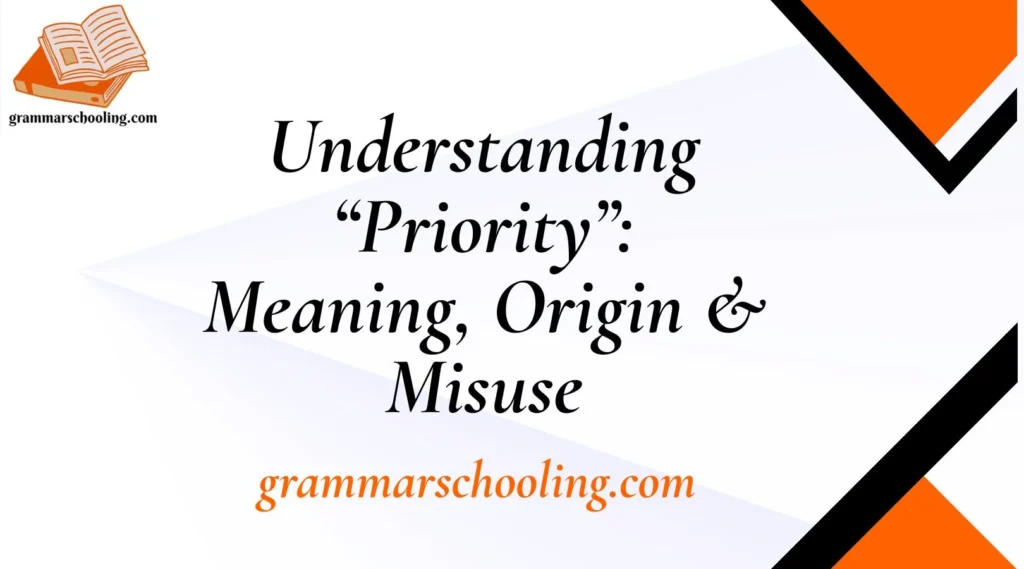In conversations and meetings, the phrase “first priority” comes up often during discussions about goals or mission statements, and it raises the question: Is It Correct to Say “First Priority”? While some argue it’s redundant since anything labeled a priority is already important, language evolves with time and meanings shift. In boardrooms, reviewing or editing documents, clarity matters more than following rigid rules of grammar and usage. I’ve found that what communicates effectively in the moment often outweighs what’s technically correct, so if saying it makes your point stronger, it’s okay to use it. Sometimes, that little phrase helps deliver the message better than perfect formality.
This article aims to unpack the idea by analyzing how words carry cultural weight and unique implications across different settings. From my experience, I’ve observed examples where the term had an impactful effect, signaling importance and sequence naturally. Some sticklers might disagree, but I believe there’s room in modern expressions for flexibility. Whether you prefer “top priority” or simply “priority,” context determines what works. In formal writing or a team chat, word choice should fit tone and intent. Through exploring alternatives to express urgency, I’ve learned that true communication depends more on clarity and tone than on perfection.
Hook: Why “First Priority” Sparks Debate
You’ve probably seen headlines, mission statements, or speeches saying something like:
“Customer safety is our first priority.”
People often flag that as awkward or redundant. Why? Because priority already means something comes first. So adding “first” seems repetitive.
Yet usage persists. Big brands say it. News media say it. Everyday speakers say it. If it’s so questionable, why does it survive?
This post answers that by digging into meaning, history, grammar, context, and style. By the end, you’ll know when “first priority” is acceptable — and when it’s better to avoid it.
Understanding “Priority”: Meaning, Origin & Misuse

Definition & Etymology
The noun priority comes from Latin prioritas (from prior “earlier”). Over centuries, English adopted it to mean “the state of being more important than something else” or “precedence.”
Because priority inherently means “first,” many argue that adding “first” duplicates the meaning. The phrase “first priority” may sound like “first first-thing.”
That said, language evolves. Sometimes redundancy becomes idiomatic. So what seems redundant to a logician might sound natural to most people.
How “Priority” Works in Usage
- “Set your priorities.” (We accept that one goal is more important than others.)
- “This is a priority.” (Implies it is among multiple options — the most important.)
- “Make safety the priority.” (We don’t say “make safety the first priority” unless emphasizing strongly.)
In many cases, using “priority” by itself is cleaner and sufficient.
The Grammar Behind the Controversy
Why People Call “First Priority” Redundant
When one word already implies “firstness,” doubling that sense can appear redundant. That’s the root of the objection: functional overlap.
Linguists call this pleonasm— the use of more words than necessary. Think “free gift” or “end result.” Often, these phrases survive because they sound natural or add emphasis.
Functional Redundancy vs. Emphasis
Not all redundancy is bad. Sometimes we repeat or overstate to strengthen a message. For example:
- “I will never, ever abandon you.”
- “She was free and clear of all debts.”
- “They came back in person.”
In such cases, the redundancy isn’t a flaw — it’s rhetorical.
Cognitive & Stylistic Roots
Humans often communicate with extra cues to reinforce urgency, clarity, or tone. Saying “first priority” may help a listener jump to attention faster.
This effect is stronger in spoken language. In writing, especially formal writing, editors often prefer tighter phrasing.
Context Matters: When “First Priority” Isn’t Wrong

The key question isn’t “Is it ever wrong?” but “When is it okay or beneficial?”
Emphasis in High-Stakes Speech
In safety announcements, speeches, or urgent alerts, redundancy can sharpen the message.
Example:“Your safety is our first priority.”
Listeners hear “safety” plus “first” — a double signal that this is top-tier importance.
Spoken vs. Written English
In speech, tone, pauses, and stress matter. Saying “first priority” helps with pacing and emphasis.
In formal writing — legal documents, technical reports, academic papers — precision often trumps emphasis. There, “top priority” or just “priority” may read cleaner and more professional.
Register, Audience & Tone
- In marketing, slogans, and leadership communication, people expect emotional language. “First priority” may work well there.
- In academic or technical documents, redundancy can look sloppy.
- In news writing or journalism, editors often cut it unless there’s reason to preserve emphasis.
“First Priority” in Real-World Scenarios
Emergency Response
In emergencies, repetition can save lives. Radio dispatch, emergency regulations, and safety protocols often employ redundancy to reduce misunderstanding.
Case Study: A fire department’s announcement:
“Your safety is our first priority.”
Here, that phrase signals urgency, clarity, and unmistakable intent.
Corporate Communication
Corporations pursue clarity and brand tone. Yet they still use “first priority” when they want to underscore a mission.
Example: In 2021, a CEO memo read:
“Our first priority is employee wellbeing.”
Here, the phrase signaled sincerity and leadership responsibility.
Journalism & PR
News outlets tend to prefer direct writing. But press releases often include “first priority” to sound strong. Editors may trim it later in headlines or copy.
Education & Policy
In policy documents or educational settings, redundancy can confuse readers, especially non-native speakers. Better to use more precise terms.
Smarter Alternatives That Sound Polished
When you want hierarchy without redundancy, try these:
- Top priority
- Primary concern
- Main objective
- Principal focus
- Core priority
Choose phrase based on tone (formal, neutral, persuasive).
Table: Alternatives & Contexts
| Alternative | Tone / Style | Best Use Case |
| Top priority | Neutral / business | Strategy, reports, memos |
| Primary concern | Formal | Research, policy, academic work |
| Main objective | Goal-oriented | Project plans, leadership writing |
| Principal focus | Elevated / formal | Speeches, formal addresses |
| Core priority | Emphatic / strong | Brand messaging, mission statements |
Redundancy in English: Sometimes a Feature
Not all redundancies are mistakes. Routinely, repetition helps us understand nuance or emphasis.
Examples of Acceptable Redundancy
- Free gift (we often say “gift” but “free gift” emphasizes no cost)
- Past history (often “history” suffices)
- End result (just “result” often works)
- Unexpected surprise (surprise already implies unexpected)
These survive because they’ve become idiomatic. They carry subtle connotations beyond literal meaning.
Functional vs. Problematic Redundancies
| Phrase | Functional / Acceptable | Problematic / Should Avoid |
| First priority | ✅ (in emphasis contexts) | ❌ (in precise writing) |
| Free gift | ✅ | ❌ if overused |
| Past history | ✅ | ❌ in concise writing |
| End result | ✅ | ❌ replace with “result” |
| Advance warning | ✅ | ❌ sometimes redundant |
Cross-Cultural Usage & Global English Trends
American vs. British English
In American English, expressive phrases, slight redundancies, and emphatic language are more tolerated. British English often prefers understatement and tighter syntax.
Thus, “our first priority” may sound normal in the U.S., while British editors might opt for “our top priority.”
Global English & Corporate Trends
In international workplaces, simple, unambiguous language is prized. Redundancy can raise translation issues.
Linguistic corpora (like Google Ngram, COCA) still show “first priority” used often — though declining in formal writing.
Expert Opinions & Style Guide Viewpoints
What Grammar Experts Say
- Some linguists argue that redundancy here is technically wrong — “first” adds nothing new.
- Others argue language isn’t just logic; usage and effect matter more.
- Many accept “first priority” in speech or persuasive messaging.
Style Guides: APA, Chicago, AP, Oxford
- AP Stylebook generally favors brevity; avoid unnecessary words.
- Chicago Manual of Style encourages clarity and precision.
- Oxford and British grammatical guides often caution against redundant phrasing.
None universally ban “first priority,” but many discourage it in formal writing unless justified by tone or emphasis.
Grammar Verdict: Acceptable, Problematic, or Justifiable?
Here’s a verdict summary that balances correctness and real-world usage:
- Grammar purist view: Redundant — you should avoid “first priority.”
- Pragmatic communicator view: Acceptable when used for emphasis, especially in spoken or persuasive writing.
- Recommended approach: Use “first priority” selectively. Prefer cleaner alternatives in formal writing. Use it sparingly when you really want to underscore something.
Checklist for using “first priority”:
- Does it add emphasis or urgency?
- Is the tone informal, spoken, or persuasive?
- Will your audience benefit from the extra emphasis?
- Would a cleaner alternative work just as well?
Conclusion
In the end, using “first priority” isn’t about breaking grammar or rules—it’s about clarity and intent. Language constantly evolves, and how we communicate effectively matters more than strict correctness. If saying “first priority” makes your message clearer, go ahead and use it. Context and tone guide good communication far better than rigid standards.
FAQs
1. Why do people say “first priority”?
People use “first priority” to emphasize urgency or sequence, even though “priority” already implies importance.
2. Is “first priority” grammatically correct?
Technically, it’s redundant, but in modern communication, it’s accepted for emphasis and clarity.
3. What’s a better alternative to “first priority”?
You can use “top priority,” “main focus,” or “primary concern” depending on your context.
4. Is “first priority” acceptable in formal writing?
It’s better to use “top priority” in formal documents, but “first priority” works in conversational or team settings.
5. What’s more important: correctness or clarity?
Clarity always wins. Communication is about being understood, not just being grammatically perfect.
Bonus Resource: Quick Reference Table — Alternatives & Ratings
| Phrase | Emphasis Level | Readability | Best Use Case |
| First priority | High | Medium | Speeches, alerts, emotive writing |
| Top priority | Moderate | High | Business, general writing |
| Primary concern | Moderate | High | Policy, academic, formal text |
| Main objective | Medium–High | High | Project, mission statements |
| Principal focus | Elevated | Medium–High | Presentations, formal addresses |
